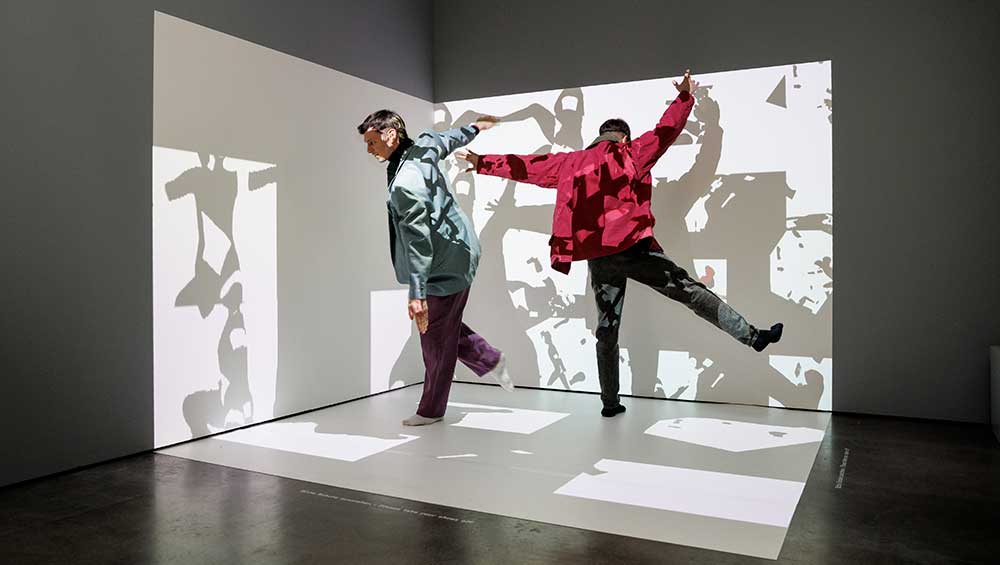
Analivia Cordeiro: From Body to Code is at ZKM (Centre for Art and Media) Karlsruhe 2023, exhibition view. Photo: Felix Grünschloß.
by BRONAĊ FERRAN
On a sharp, bright, blue-sky day in mid-February, I enter the ZKM (Centre for Art and Media) in Karlsruhe, in the south-western Baden-Württemberg region of Germany. A former armaments factory, built in precast concrete more than a century ago, it remained active during the second world war, then re-opened as an art and media museum in 1997. I am shortly to interview Analivia Cordeiro, a Brazilian artist, choreographer and dancer and pioneer of computational and video-dance practices from the early 1970s onwards, and I have come here to see the first comprehensive exhibition in Europe of her works. When I speak to Cordeiro (b1954) soon after my visit, she tells me: “ZKM means memory, it means history and it’s a kind of survival of memory. They understand what I do. I was very, very lucky: they can place it in history, the right place. They recovered the quality of all the videos.”
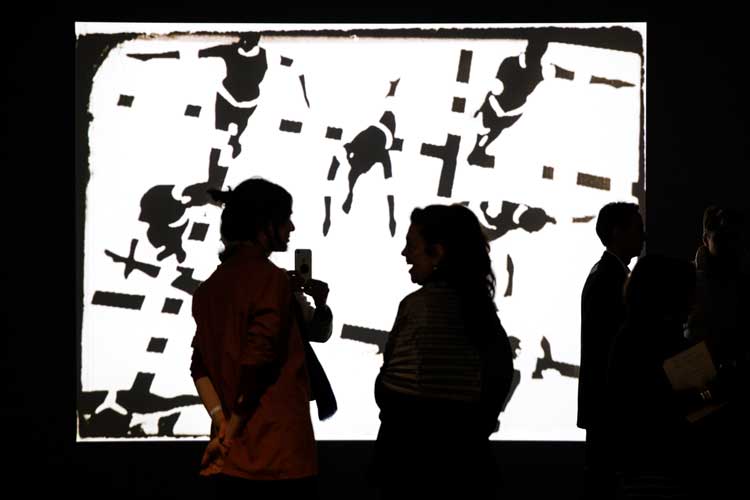
Analivia Cordeiro: From Body to Code is at ZKM (Centre for Art and Media) Karlsruhe 2023, exhibition view. Photo: Felix Grünschloß.
Cordeiro is best known for a prodigiously early dance-video work entitled M3X3 made in 1973 when she was 19. It is included as a seminal work of dance and technology in an exhibition of early computer-related art at the Los Angeles Museum of Art. Asked why she thinks this work is now gaining such positive recognition, more than half a century after she made it, Cordeiro says: “I predicted the way the body would move, those movements cut it, they are very orthogonal: break-dancing, street dancing, they all move this way now. I suppose I was predicting the body language that would come later.”
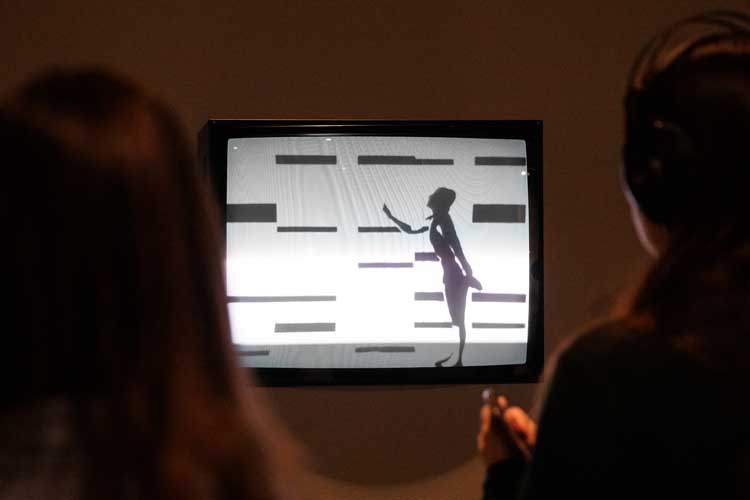
Analivia Cordeiro: From Body to Code is at ZKM (Centre for Art and Media) Karlsruhe 2023, exhibition view. Photo: Felix Grünschloß.
A digital version, along with gelatin-print photographic stills, form a key feature of the ZKM exhibition’s opening room. A wall text tells us that a “16mm film copy of the video from 1973” had entered the ZKM collection in 2021 “as part of the archive of the bcd CyberneticArt team” donated by Dunja Donassey-Bonačić, wife of Vladimir Bonačić, a Croatian-born artist with whom Cordeiro corresponded in 1974. Only two 16mm versions of the work were ever made. The discovery of one in the bcd CyberneticArt team archive exemplifies a dynamic process of feedback between collecting, restoration and contemporary curation that ZKM is now generating.
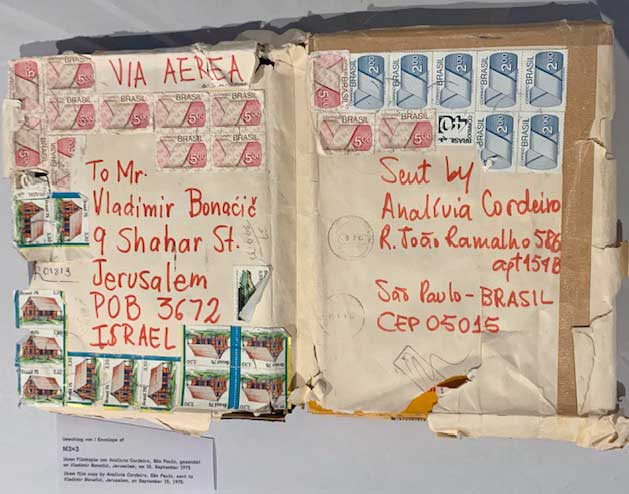
Letter sent by Analivia Cordeiro to Vladimir Bonačić, 1974, installation view, From Body to Code, ZKM (Centre for Art and Media), Karlsruhe 2023. Photo: Bronac Ferran.
When given to ZKM, the film of M3X3 was still in the original envelope, sent by Cordeiro from São Paulo in 1975, hand-addressed and festooned with Brazilian stamps. The envelope is on view in the opening room of the exhibition in a large vitrine to the left of the large screen displaying M3X3. The video transmits a haunting sense of a futurist vision as well as an uncanny contemporaneity. The dancers appear to merge with the flatness of the screen, dressed in strict monotone and moving, as Cordeiro has emphasised, in highly orthogonal directions.
In the vitrine, there is also a text about the making of the work that Cordeiro sent to be read, in her absence, at an event convened by the Computer Arts Society at the Edinburgh International Festival in 1973. Presented by the computer dance specialist John Lansdown, a copy of the paper was retained by the chair of the panel, the artist Manfred Mohr, whose valuable personal collection of archival materials is now also in the ZKM collection. As a pristine material artefact, it is emblematic of the care taken by leading pioneers in this field to preserve the first steps towards the growth of what are now ubiquitous digital media art practices. Among letters on display in other vitrines is one from the scientist and pioneering digital artist Herbert W Franke to Cordeiro offering encouragement and support for what she was doing.
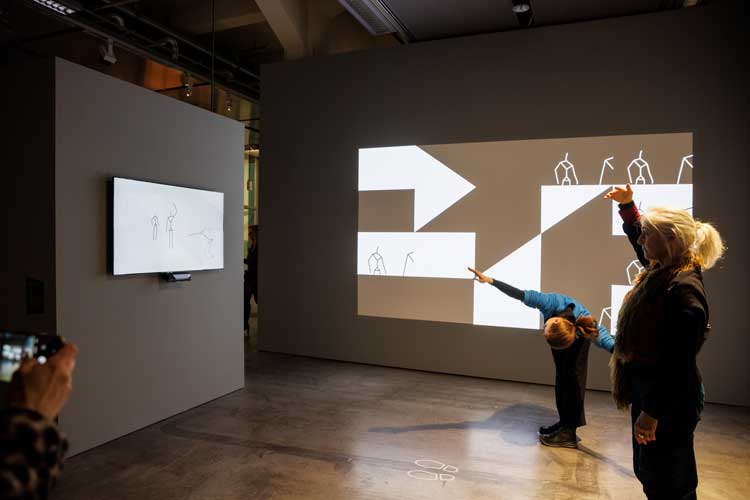
Analivia Cordeiro: From Body to Code is at ZKM (Centre for Art and Media) Karlsruhe 2023, exhibition view. Photo: Felix Grünschloß.
Cordeiro tells me about her first meeting with Bonačić, during his visit to São Paulo in 1971 for Arteônica, a festival organised by her father, Waldemar Cordeiro. On that occasion, Bonačić introduced the 17-year-old Analívia to the concept of random choice in mathematics and to the Fortran programming language, which she afterwards taught herself to use. She was then invited by Bonačić to a festival in Israel in 1974 and on his request sent the work to him in its 16mm version afterwards. Cordeiro recalls being “at least 20 years younger than the youngest members” of the group of computer art pioneers who gathered for Bonačić’s seminar in 1974.
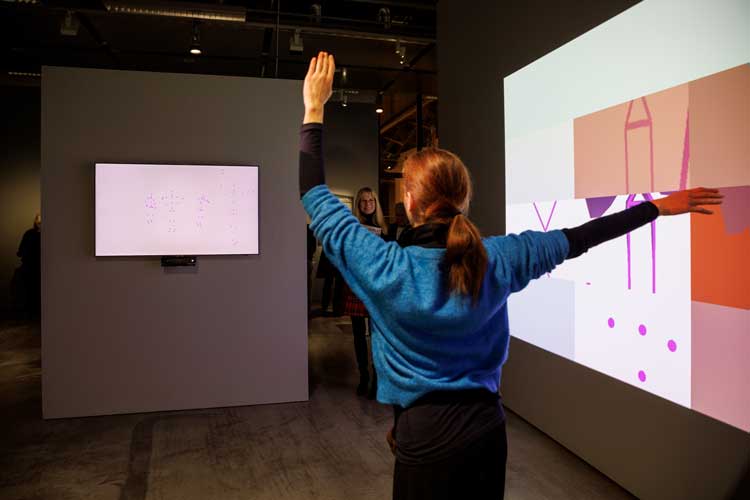
Analivia Cordeiro: From Body to Code is at ZKM (Centre for Art and Media) Karlsruhe 2023, exhibition view. Photo: Felix Grünschloß.
What the curatorial approach in this exhibition makes clear is that, from the outset, Analivia Cordeiro’s choreographic, computer-related, video-dance material was exploring the shifting interface between human gesture and an algorithmic ascendant. It also brings into new focus how her work built on an extended specific intercultural and intergenerational trajectory. Her father was an artist and art theorist as well as a landscape gardener. Born in Rome to an Italian mother and Brazilian father and brought up in Brazil, he led a move towards a mathematically infused, geometrically aligned concrete art that came into the ascendant among visual artists in Brazil in the early to mid-1950s. He was active in transferring aspects of the mathematical basis of concrete art and its industrial art associations into the sphere of adaptive structures, in which the idea of collectivising movement was implicit. A pioneer of politically engaged computer art practices, his influence permeated the formative stages of his daughter’s development. She then shifted the orthogonal movement of line and planes within concrete art production into enhanced kinaesthetic and then three-dimensional directions.
Cordeiro is conscious of her specific place within a specific lineage, noting: “My father, every day, was talking about the idea of visual gestalt and of industrial art, and I was looking at books of Mondrian, and hearing about concrete art.” And, she says: “There is a little detail, which may be of interest to psychologists. When I was a baby in my cot, my father put up a replica of an Alexander Calder mobile. So, I was watching this sample of modern art from when I was three months. So, I have this in my neurological system. There is a family photo of me lying down and watching it.”
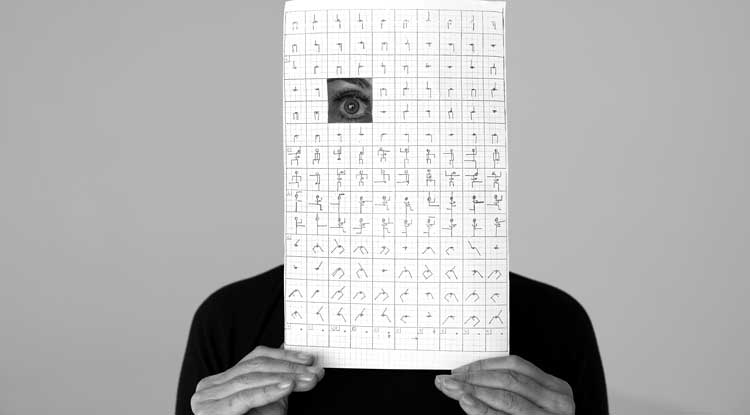
Bob Wolfenson, Studio portrait of Analívia Cordeiro, 2020. Black and white photography.
© Bob Wolfenson
Cordeiro learned dance from the early 60s in São Paulo under Maria Duschenes, a Hungarian-born dance teacher who had studied at Dartington Hall in England in the late 1930s with Rudolf von Laban. On moving to Brazil, Duschenes married a German-born art historian. Cordeiro recalls Duschenes bringing her students to the Goethe Institut in the city to watch the Triadic Ballet created in 1922 by Oskar Schlemmer, a Stuttgart-born artist, sculptor and Bauhaus tutor. Although “very young”, Cordeiro says she returned alone to see the film again and again: “I would be the only one there and I would imitate the film: not intellectually but through my body. So, I absorbed as a girl the message of Schlemmer.” A grandson of Schlemmer’s was present for the opening night of the current ZKM show, which reinforced the significance of this relationship and the location of the exhibition for Cordeiro.
The show was proposed and curated by media art specialist Claudia Giannetti, who first met Cordeiro in Barcelona in 2016 at an exhibition of her work organised by the Anita Beckers Gallery in Frankfurt. At ZKM in January this year, Giannetti introduced Cordeiro to Peter Weibel, ZKM’s long-term chairman and CEO, who was also an early video art practitioner.* Cordeiro has described their initial meeting: “He asked if we might make a video of our first talk. I said OK. I realised he was a performer and so before talking, I told him: ‘I want to talk with you with movement, so let’s do it with our hands.’ All the time, he was doing this type of movement, making a two-dimensional X and Y axes, and I then finished the conversation with the third dimension. I love mathematics and I love performance and so it was perfect.”
Weibel also questioned Cordeiro closely about her approach, telling her that in his view she had taken a historically groundbreaking step in inscribing space into the dancer’s body. Cordeiro explained that, for her, the movement of the human being creates volume in space and that she had sought to do this expressively, through resistance or through interaction with gravity. The exhibition has numerous detailed drawings and sketches by Cordeiro that give us a privileged insight into the underlying substructures inherent to her working processes, that show a meeting point between dance notation and mathematical calculations. Describing to me her curatorial approach to this exhibition, Giannetti stated: “I wanted to reflect the procedural logic of the works, the work itself, and the documentation that certifies the chronology.” As Giannetti has also noted, what this then valuably achieves is the reconstruction of the artistic history of Cordeiro's production from the 70s onwards.
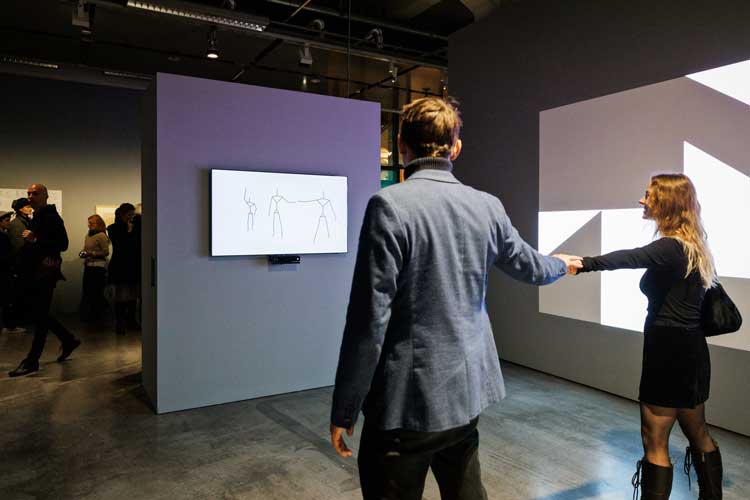
Analivia Cordeiro: From Body to Code is at ZKM (Centre for Art and Media) Karlsruhe 2023, exhibition view. Photo: Felix Grünschloß.
As you move from the first room to the last, moreover, it is clear how, over the decades following her initial groundbreaking production of video-dance projects, Cordeiro developed a practice in which a profound and multidimensional engagement with what she calls “the language of movement” stretched out from close working with the trained bodies of dancers interacting with film and video cameras into the active space of participatory public engagement. I witnessed this in action, observing how younger visitors, in particular, interacted with the works being presented, dancing enthusiastically in front of visual displays based on a system of notation named Nota-Anna, which Cordeiro first conceptualised in the early 80s. She has developed it in close collaboration with Nilton Lobo, an engineer and programmer, to whom she is now married. They describe it as an “an annotation system for human movement” that registers the trajectory of a body’s movement in space and time and then makes it available in a form of digital transference on to a computer screen or elsewhere.
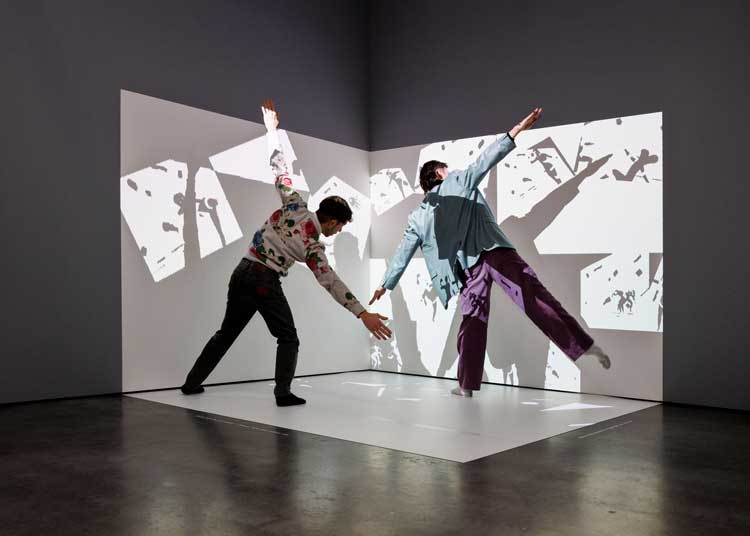
Analivia Cordeiro: From Body to Code is at ZKM (Centre for Art and Media) Karlsruhe 2023, exhibition view. Photo: Felix Grünschloß.
Examples of the evolution of this notation in various applications from the 80s onwards are on view as you move through the spaces of the gallery, including a stunning video that shows the application of this software this century to a quasi-balletic movement of the late Brazilian footballer Pelé, captured on television camera in 1968. Indeed, a sense of a generation of modes of transference from one format to another that has accompanied Cordeiro’s works over several decades – and is now at the heart of our contemporary mediated culture – makes this exhibition’s timing particularly exciting.
Adding to its quality of effect for the visitor is an aural overlap between the metronomic beat of M3X3 and the percussive repetitions and adaptations of the score accompanying another early audiovisual work entitled Cambiantes [Changing] (1976). The detailed attention given to showing various detailed aspects of the process of development and production of Cambiantes exemplifies the narrative of the overall exhibition. Two versions, the first made in 1976 with choreography, computation and video, and the second, in 2014, as a three-screen projection, encouraging human interaction, are being shown. In its 1976 format, the lines of the dancer’s limbs are highly constrained and specifically situated to register the limitations of the technical framing within which they are moving. The soundtrack (created in advance of Cordeiro’s work) by the Brazilian composer Raul do Valle in 1975 adds a structured tonality that complements the video’s stripped-back visual register.
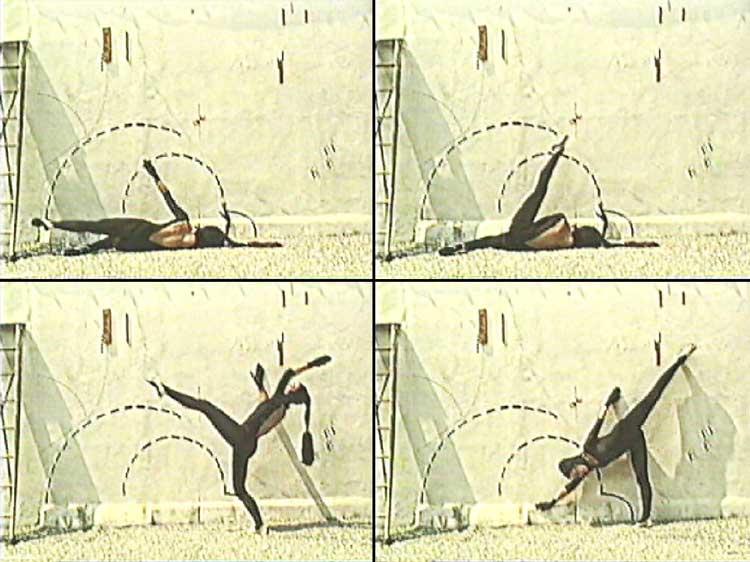
Analivia Cordeiro, Ar (Air), 1985. Mono-channel video, (colour, sound). Video still frames. Performer: Analívia Cordeiro. © Analivia Cordeiro.
Cordeiro tells me: “There is something very special about this work. In 1975, I was working with technology, but realised that what was needed was to understand the human being. It was becoming obvious that technology would run our world: you didn’t have to be very intelligent to see that the world needed technology the way that it was going, the way people were trying to understand each other globally.”
Then a master’s student, she applied to spend some time living with an Amazonian tribe, the Kamaiurá, perceiving that they were then somehow outside the growing technological dominant. She says: “I lived [with them] for two and a half months and I registered a whole ritual so as to grasp not only the dance because they don’t have a separation between dance and ideas, they have one thing that is a whole. I recorded the material professionally on Super8 film and when I came back, I made Cambiantes, which takes some of what I had experienced there and transfers it into the rectangular space of the screen. In fact, it challenges that dimension. I painted the dancers’ faces with triangles, in the same way as I had seen happen in the Amazon. I also introduced a movement of ‘rebound’ for the body, like [the video game] Pong, to swing like a pendulum. It was different from the movement that I had used a few years earlier. It was orthogonal, but it was very organic at the same time. This came from what I observed among the tribal people. I used the weight of the body for the dance, which creates a feeling that you can see and feel when you, as part of the public, see the dance. Through your eyes, you connect your synaesthetic system and you feel the movement of the dancer, so Cambiantes used this weight and this gravity to achieve its effect.”

Slow Billie Scan, 1987. Telepresence dance using slow scan television. Mono-channel video 4:3 (colour, sound), 4:80 min. Video still frames. Performers: Analivia Cordeiro and Lali Krotoszynski. © Analivia Cordeiro.
For me, the resulting work exemplifies what Cordeiro calls “video choreography”, involving, as the Brazilian media theorist Arlindo Machado has noted, “an indecomposable visual unity connection or relation between the camera and body movement”.1 To make this project in the middle of the 1970s, Cordeiro drew on her developing skills in Fortran IV to blend computation, human movement and video.
She talked to me about her current focus on evolution of her notation, which she hopes may become universally transferable. She sees this as imperative following a global pandemic during which as she puts it: “We all became dependent on technology. But technology makes the human expression poorer, it gives you rules, everything is inside a rectangle; I saw early and clearly that video art is very limiting of expression. Instead of giving opportunity, it is limiting and imposes rules that make our expression poorer, not rich. I am therefore asking: ‘Why not transform this into three dimension, where we can really interact?’ For me, movement is an escape of the technological rules.”
She wants to develop Nota-Anna, she says, to “make it easy for any person, of any age, any culture, any place in the world”, noting that “movement is universal – we can see this in any person, in any place, everybody has the same body, I am concerned with talking through the body and the language of movement. Yet, you know a strange thing is that, despite the fact that it is universal, this is not something that we yet fully understand. The need to find a way of writing movement is very serious proposition. Can you imagine, we have thousands of years of human culture but there is not a way of writing movement? It is like a black hole. This is what I want to encourage. It goes beyond art into the survival of the human. Without movement we die. It is quite simple.”
Reference
1. Arlindo Machado, in Analívia Cordeiro, Human Motion: Impression/Expression, trans. Isabel Burbidge, (Frankfurt, 2016; São Paulo, 2018), page 85. This informative publication with a chronology of her work and diverse texts, essays, images and archival material is available at Analívia Cordeiro’s website.
* On 1 March, after this interview took place, Peter Weibel, who had led ZKM since 1999, died following a short illness. In April 2023, he will be succeeded by Alastair Hudson.
• Analivia Cordeiro: From Body to Code is at ZKM (Centre for Art and Media Karlsruhe) until 23 April 2023.